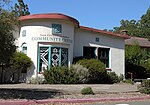Nicasio, California

Nicasio ( nih-KAH-see-oh; Spanish for "Nicasius") is an unincorporated community and census-designated place in Marin County, California, United States. It is located 8 miles (13 km) west-southwest of Novato, at an elevation of 194 feet (59 m). As of the 2020 census the CDP population was 81, while population estimates for the surrounding area range from about 600 to about 900 people.Within Nicasio and the surrounding area are about 250 homes located on approximately 350 parcels. Much of the land is still used for agricultural purposes including beef and dairy cattle grazing, small-scale truck farming (including organic farming), and the raising of forage. Several small vineyards have also been recently established. Next to Rancho Nicasio within the town of Nicasio is an organic farm, AllStar Organics, owned and operated by Janet Brown and Marty Jacobson; Janet is the vice-president of Marin Organic, Marin County's non-profit organic association. Just north of Nicasio Reservoir is Fairlea Ranch, where pedigree longhorn cattle are raised. The most significant non-agricultural business within Nicasio is George Lucas' Skywalker Ranch, a part of Lucasfilm Ltd. According to a 2004 Forbes magazine real estate survey, Nicasio is the 23rd most expensive ZIP code in the US. Nicasio has the highest per capita income ($211,993) of any census-designated place in California.Centrally located in this area is the small village of Nicasio itself. The village is in area codes 415/628. The town center has a post office (ZIP code 94946), a general store, a tiny real estate office, St. Mary's Catholic Church (established in 1867), Nicasio Volunteer Fire Department, a baseball field located in the town square, the Rancho Nicasio Bar & Restaurant, a Druid's Hall, as well as a number of private homes. The town was founded in the early 19th century to support local agricultural, timber, and fishing activities. The town once contained the twenty-two-room Hotel Nicasio, which opened in 1867 but burned down in December 1940. Just north of town on Nicasio Valley Road next to the modern-day school building for Nicasio School District is a one-room schoolhouse that opened in 1871. The building is currently a listed historical landmark. The Nicasio post office opened in 1871, closed in 1899, and reopened in 1900.In 2008, Dewey Livingston wrote a detailed history of the region titled Nicasio: The Historic Valley at the Center of Marin.
Excerpt from the Wikipedia article Nicasio, California (License: CC BY-SA 3.0, Authors, Images).Nicasio, California
Old Rancheria Road,
Geographical coordinates (GPS) Address Nearby Places Show on map
Geographical coordinates (GPS)
| Latitude | Longitude |
|---|---|
| N 38.061666666667 ° | E -122.69861111111 ° |
Address
Old Rancheria Road
94946
California, United States
Open on Google Maps






